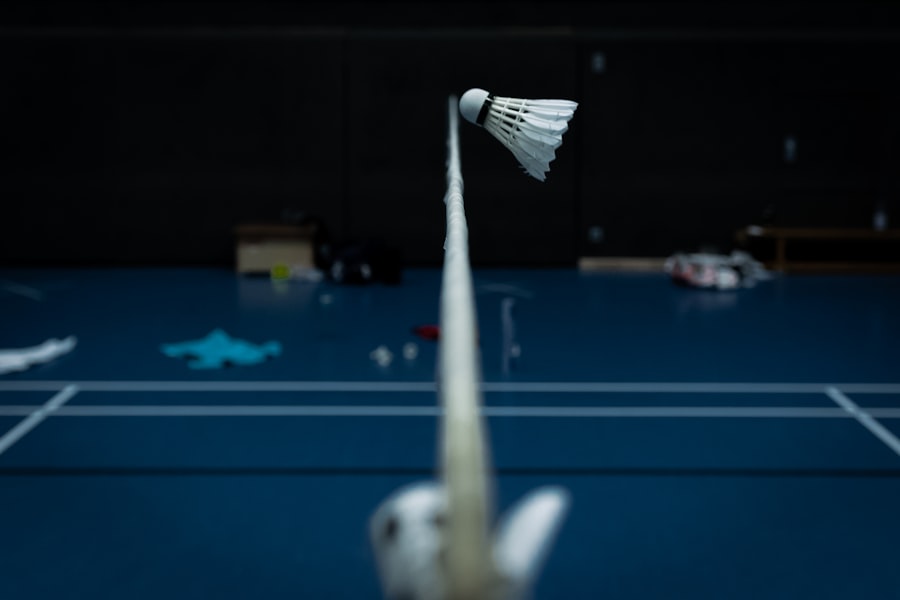Mastering the Art of Badminton: Tips and Techniques
Description
Badminton is a fast-paced racquet sport that has gained immense popularity worldwide, characterized by its unique blend of agility, strategy, and precision. The game is played with a shuttlecock, which is a feathered projectile that players hit back and forth over a net. The objective is to score points by landing the shuttlecock in the opponent’s court while preventing them from doing the same.
The sport can be played in singles or doubles formats, each requiring different skills and strategies. Understanding the basic rules, scoring system, and court dimensions is essential for anyone looking to engage in badminton, whether casually or competitively. The court itself is rectangular, measuring 13.4 meters long and 6.1 meters wide for doubles play, while the singles court is slightly narrower at 5.18 meters.
The net stands at a height of 1.55 meters at the center and 1.524 meters at the sides. Players must serve from behind the service line, and the shuttlecock must pass over the net and land within the designated boundaries to be considered in play. Scoring in badminton follows a rally point system, where points can be won by either player or team regardless of who served.
Familiarity with these fundamentals lays the groundwork for developing more advanced skills and strategies.
Key Takeaways
- Badminton is a fast-paced racket sport played with a shuttlecock, requiring agility, speed, and precision.
- Proper footwork and movement are essential for covering the court efficiently and reaching the shuttlecock in time.
- Mastering different types of shots, such as clears, smashes, drops, and net shots, is crucial for a well-rounded game.
- Improving grip and control of the racket can significantly enhance the accuracy and power of your shots.
- Learning effective strategies and tactics for both singles and doubles play can give you a competitive edge on the court.
Developing proper footwork and movement on the court
Footwork is a critical component of badminton that can significantly influence a player’s performance. Effective footwork allows players to position themselves optimally for each shot, ensuring they can respond quickly to their opponent’s actions. The ability to move swiftly and efficiently around the court not only enhances shot execution but also helps maintain balance and control during play.
Players should focus on developing a light, agile stance that enables quick lateral movements, forward sprints, and backward retreats. One effective way to improve footwork is through specific drills that emphasize agility and speed. For instance, players can practice shadow badminton, where they simulate movements without hitting a shuttlecock.
This exercise helps in refining foot placement and movement patterns without the distraction of actual gameplay. Additionally, incorporating ladder drills can enhance coordination and quickness, allowing players to navigate the court more effectively. By mastering footwork techniques such as the split step, lunges, and quick pivots, players can gain a significant advantage over their opponents, enabling them to reach shots more efficiently and set up for their next move.
Mastering the different types of shots in badminton

A comprehensive understanding of various badminton shots is essential for any player aiming to excel in the sport. Each shot serves a specific purpose and can be employed strategically depending on the situation during a match. The fundamental shots include clears, drops, smashes, drives, and net shots.
Each shot requires distinct techniques and timing to execute effectively. The clear shot is often used to push the opponent to the back of the court, creating space for subsequent attacks. It involves hitting the shuttlecock high and deep into the opponent’s court.
In contrast, drop shots are executed with finesse, aimed just over the net to catch opponents off guard.
Net shots require delicate touch and precision, as they are played close to the net to force opponents into difficult positions. Mastering these shots involves not only technical skill but also an understanding of when to use each shot effectively during gameplay.
Improving your grip and control of the racket
| Technique | Benefits |
|---|---|
| Proper grip | Improved control and power |
| Hand strength exercises | Better grip on the racket |
| Finger dexterity drills | Enhanced maneuverability |
| Wrist flexibility exercises | Increased range of motion |
The grip on the racket is one of the most fundamental aspects of playing badminton effectively. A proper grip not only enhances control over shots but also influences power generation and shot accuracy. There are two primary grips used in badminton: the forehand grip and the backhand grip.
The forehand grip is typically used for most shots, while the backhand grip is essential for executing backhand strokes. To achieve a proper forehand grip, players should hold the racket as if shaking hands with it, ensuring that their thumb rests against the flat surface of the handle for added support. This grip allows for maximum wrist flexibility and power during strokes.
Conversely, the backhand grip requires players to rotate their hand slightly so that the thumb presses against the back of the handle, providing stability for backhand shots. Practicing these grips consistently will lead to improved control over shot placement and execution. Additionally, players should focus on maintaining a relaxed grip; tension in the hands can hinder fluidity in movement and shot production.
Learning effective strategies and tactics for singles and doubles play
Understanding strategic play is crucial for success in badminton, as it allows players to outmaneuver their opponents through calculated decisions on shot selection and positioning. In singles play, players often rely on a combination of power and placement to control rallies. They must be adept at creating angles and exploiting weaknesses in their opponent’s game while maintaining their own court coverage.
In doubles play, teamwork becomes paramount. Players must communicate effectively with their partner to establish formations that maximize their strengths while minimizing vulnerabilities. Common strategies include adopting an attacking formation where one player takes on a more aggressive role at the net while the other covers the backcourt.
This dynamic allows for quick exchanges and pressure on opponents. Additionally, players should develop an understanding of rotation patterns during rallies to ensure they maintain optimal positioning throughout the match. By analyzing opponents’ tendencies and adapting strategies accordingly, players can gain a competitive edge in both singles and doubles formats.
Enhancing your physical fitness and conditioning for badminton

Physical fitness plays an integral role in badminton performance, as it directly impacts a player’s agility, endurance, strength, and overall ability to execute skills effectively during matches. Badminton requires quick bursts of speed combined with sustained energy levels throughout gameplay; therefore, conditioning programs should focus on developing both anaerobic and aerobic capacities. Incorporating interval training into fitness routines can significantly enhance cardiovascular endurance while mimicking the stop-and-go nature of badminton matches.
Exercises such as sprints followed by short recovery periods can improve stamina and speed on the court. Strength training is equally important; exercises targeting core stability, leg strength, and upper body power contribute to better shot execution and injury prevention. Plyometric exercises like box jumps or medicine ball throws can also enhance explosive power necessary for smashes and quick movements around the court.
Utilizing mental focus and concentration during matches
Mental fortitude is often overlooked in sports training but is crucial for achieving peak performance in badminton. Players must cultivate mental focus to maintain concentration throughout matches, especially during high-pressure situations where distractions can easily derail performance. Techniques such as visualization can be beneficial; players can mentally rehearse successful shots or match scenarios to build confidence before stepping onto the court.
Additionally, mindfulness practices can help players stay present during matches, reducing anxiety and enhancing decision-making abilities. Breathing exercises can also aid in maintaining composure during intense rallies or when facing challenging opponents. Developing a pre-match routine that includes mental preparation can set a positive tone for competition, allowing players to approach each match with clarity and confidence.
Incorporating drills and practice routines to improve your skills
Regular practice is essential for skill development in badminton; however, it is equally important to incorporate structured drills that target specific areas of improvement. A well-rounded practice routine should include technical drills focusing on shot execution, footwork exercises for agility enhancement, and tactical simulations that mimic match conditions. For instance, players can set up drills that involve hitting specific targets on the court to improve accuracy or practice rallying with a partner using only certain types of shots to develop consistency in execution.
Incorporating game-like scenarios into practice sessions can also help players adapt their skills under pressure while reinforcing strategic thinking during play. Consistency in practice routines not only leads to skill enhancement but also fosters muscle memory, allowing players to perform effectively during actual matches without overthinking their movements or decisions. By focusing on these various aspects of badminton training—ranging from understanding game fundamentals to honing physical fitness—players can develop a comprehensive skill set that enhances their overall performance on the court.
Each element contributes uniquely to becoming a well-rounded player capable of competing at higher levels while enjoying the sport’s dynamic nature.
If you are a fan of Badminton, you may also be interested in reading about the most rated apps for mobile gaming. Check out the article here to discover some new games to play on your phone in between badminton matches.
FAQs
What is badminton?
Badminton is a racquet sport played by either two opposing players (singles) or two opposing pairs (doubles), who take positions on opposite halves of a rectangular court divided by a net.
What equipment is used in badminton?
The primary equipment used in badminton includes a shuttlecock (also known as a birdie), badminton racquets, and a net. Players also wear appropriate footwear for the sport.
What are the basic rules of badminton?
The basic rules of badminton include serving diagonally, scoring points by landing the shuttlecock within the opponent’s court, and winning a match by winning two out of three games.
What are the health benefits of playing badminton?
Playing badminton can provide various health benefits, including improved cardiovascular fitness, agility, flexibility, and hand-eye coordination. It also helps in burning calories and promoting overall physical well-being.
What are the different types of badminton shots?
Some of the different types of badminton shots include the clear, drop shot, smash, drive, and the lob. Each shot has its own specific technique and purpose during a game.
What are the major badminton tournaments and events?
Major badminton tournaments and events include the All England Open Badminton Championships, BWF World Championships, Thomas Cup (men’s team event), Uber Cup (women’s team event), and the Olympic Games. These events feature top players from around the world competing at the highest level.





